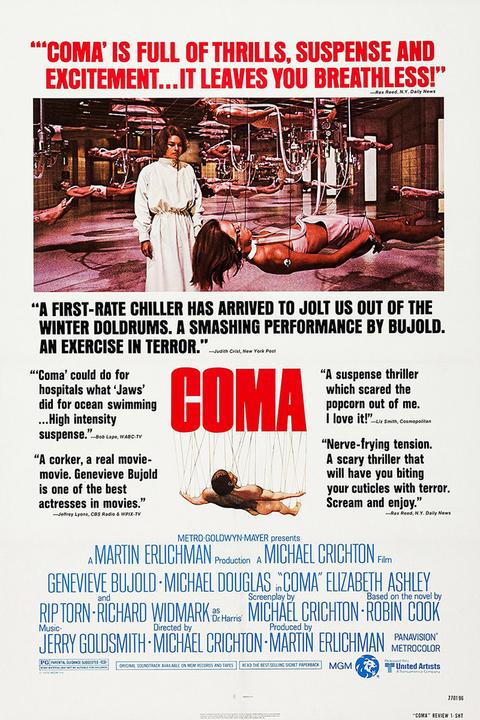An unusual number of operations ending in patient comas at a large metropolitan hospital arouse the suspicions of a surgical resident, whose concerns aren’t at first taken seriously.
No doubt about it. In Coma, Geneviève Bujold is front and center in this science fiction/horror movie/romance, clearly the dominating force, although her live-in boyfriend thinks she’s paranoid about patient deaths. Bujold is practically in every scene and earned an Oscar nomination.
Her presence is far above and beyond that of her romantic co-star Michael Douglas, who is usually screen-center in any movie he makes. His lack of enthusiasm, in fact, makes this a borderline romance at best. Except for the required lovers’ roll in the surf and romp through the heather—usually brief and almost nonsexual here—he simply stands around most of the time, only coming to life for the climax.
Two doctors have collaborated on this medical roller-coaster of a horror story, which is made most realistic and believable through its operating room scenes and the technical terms which are casually banded about. As if all the viewers have medical degrees; pick up a medical dictionary at the door!
Michael Crichton, who directed the film, deciding not to pursue medicine after he received his MD degree from Harvard, turned instead to writing medical fiction. The best of his novels turned into movies include The Andromeda Strain (1969) and, of course, Jurassic Park (1990).
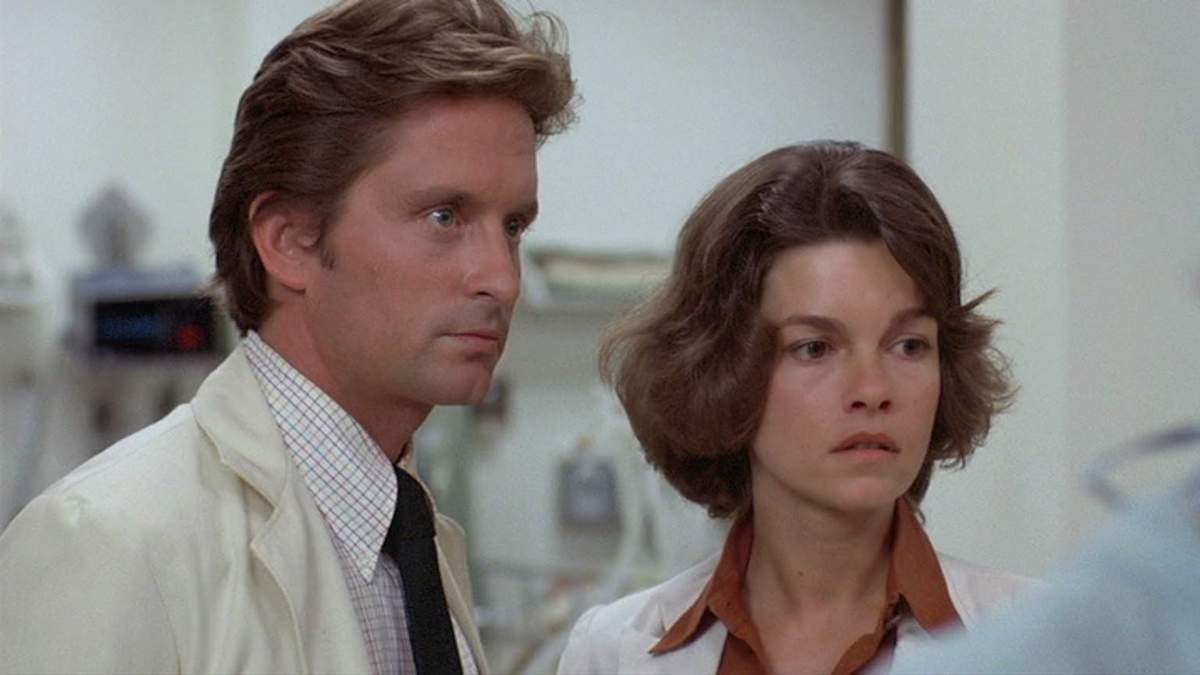 Coma is based not on a book by Crichton, but on one by another medical doctor, Robin Cook who, though a surgeon and ophthalmologist, also writes in the fantasy/science fiction genre. His works often illustrate how our current technology can become a runaway monster, beyond man’s understanding and control.
Coma is based not on a book by Crichton, but on one by another medical doctor, Robin Cook who, though a surgeon and ophthalmologist, also writes in the fantasy/science fiction genre. His works often illustrate how our current technology can become a runaway monster, beyond man’s understanding and control.
Dr. Susan Wheeler (Bujold) is a surgical resident at Boston’s Memorial Hospital. When her best friend Nancy Greenly (Lois Chiles, the first of several murder victims in Death on the Nile, 1973) ends up comatose during a routine operation, she becomes concerned.
Various medical associates, including boyfriend Dr. Mark Bellows (Douglas), explain that Boston Memorial is a large hospital with about 30,000 operations a year and such deaths—never called “errors”—should be expected.
She asks a computer technician (Gary Barton) to violate file security and generate printouts of the year’s “surgical patients with general category of coma”—part of the abundant technical jargon. She is surprised by the high number of deaths.
When another patient, Sean Murphy (Tom Selleck), is pronounced brain dead after a simple knee operation—Mark still remains unsympathetic—she requests Dr. George (Rip Torn), Chief of Anesthesiology, review some twelve cases involving comatose deaths. He adamantly refuses.
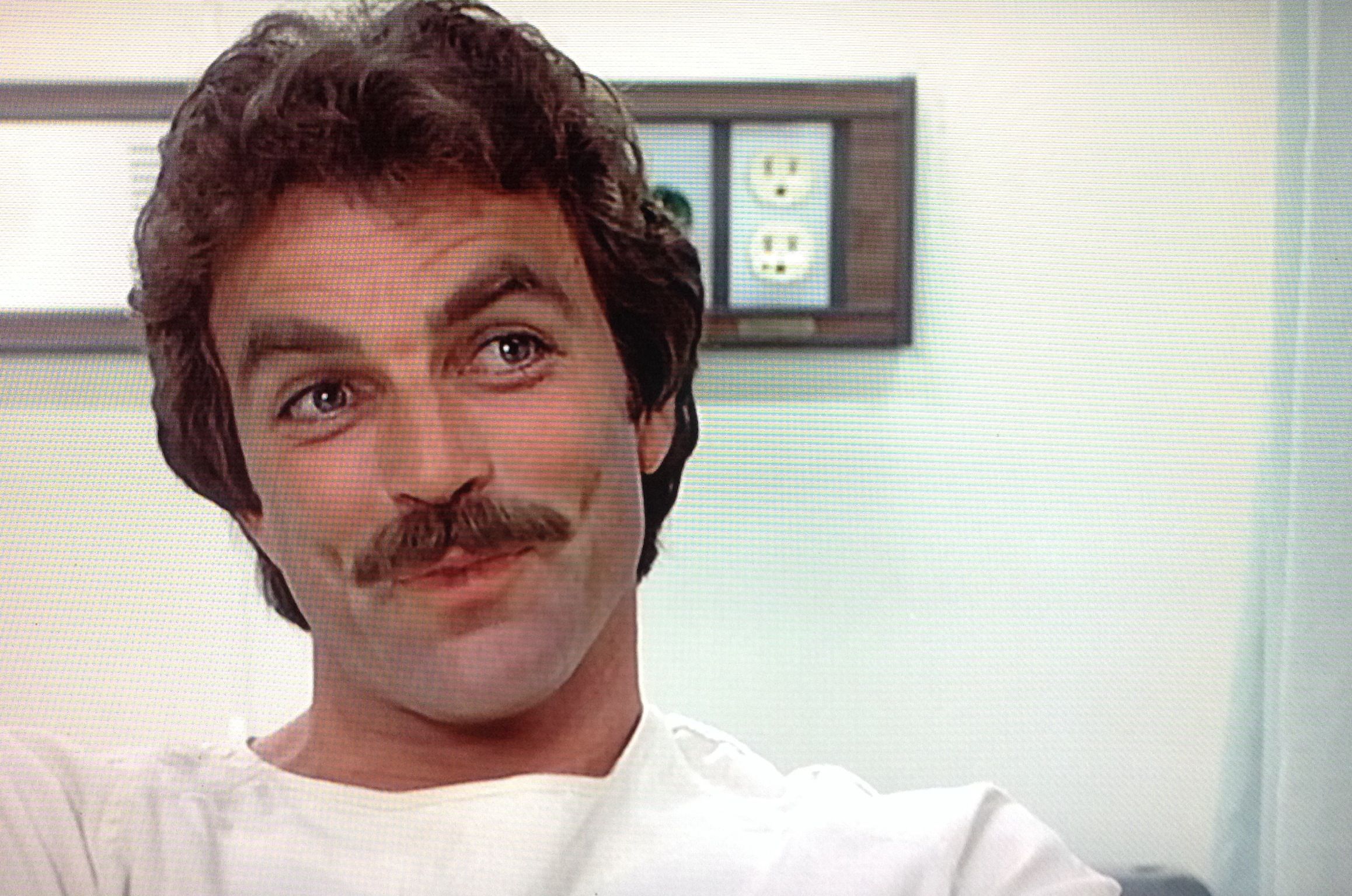 Susan then learns that Murphy’s body is to be transferred to something called the Jefferson Institute.
Susan then learns that Murphy’s body is to be transferred to something called the Jefferson Institute.
A pathologist (Richard Doyle) theoretically discusses with her just how could a doctor commit a murder. He suggests something simple, colorless and undetectable—carbon monoxide.
Dr. George has relayed Susan’s inquiries to Chief of Surgery, Dr. George Harris (Richard Widmark), who calls her to his office and suggests she is still grieving over the loss of her friend Nancy and gives her a weekend to recuperate.
Before that week is out, however, she tells Mark that her further investigations reveal that both Nancy and Sean “died” in operating room 8. Mark remains unconvinced that anything is improper.
Susan and Mark spend that weekend at the beach. On their return to Boston they see a sign for the Jefferson Institute. While Mark waits in the car—by now the audience might well wonder if Mark isn’t somehow involved—she proceeds alone to the glass-door entrance. A frosty nurse (Elizabeth Ashley) states the facility is closed but a physicians’ tour will be conducted next Tuesday.
In the meantime, the hospital maintenance man (Dick Balduzzi) who overheard Susan’s talk with the pathologist suggests that if she wants to know about OR 8, she should meet him in maintenance. Before she can, an assailant (Lance LeGault, later Colonel Decker in the TV series The A-Team) douches him with water and pushes him into the generator, and he’s electrocuted.
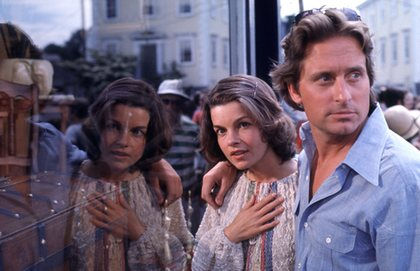 Working on the carbon monoxide theory, Susan finds in the hospital basement a green cylinder with a line leading up a service ladder. She follows it up several floors and across the crawl space to where the line passes through some electronic triggering device, then down into OR 8.
Working on the carbon monoxide theory, Susan finds in the hospital basement a green cylinder with a line leading up a service ladder. She follows it up several floors and across the crawl space to where the line passes through some electronic triggering device, then down into OR 8.
Later, while Susan is searching through a file and discovering that all the twelve patients became comatose in OR 8 and were moved to the Jefferson Institute, she hears a knock on the door. Security the voice announces. She’s suspicious and flees into a teaching theater. She’s followed and temporarily repels the man with foam from a wall fire extinguisher, then finally, in the morgue, buries him under a pile of bagged corpses.
She returns to the Institute the next Tuesday. The brain-dead “patients” are suspended mid-air from the ceiling by wires around their necks and hips, intravenously fed, vital signs monitored and “needs” computer-adjusted. This is the signature image of the film.
Slipping away from the tour to the deserted parts of the building, she realizes the place actually deals in the black-market sale of patients’ organs to the highest bidders. Her presence is detected on surveillance cameras, but she escapes on the roof of a departing ambulance.
Now it is Susan who goes to Dr. Harris, sharing with him her discoveries. As patient and consoling as before, he seems quite sincere: “Now the question is, how do we handle this?” The drink he offers her, however, is drugged, and as she passes out, he admits to everything and explains why “We must always take the long view. . . . The individual is too small.”
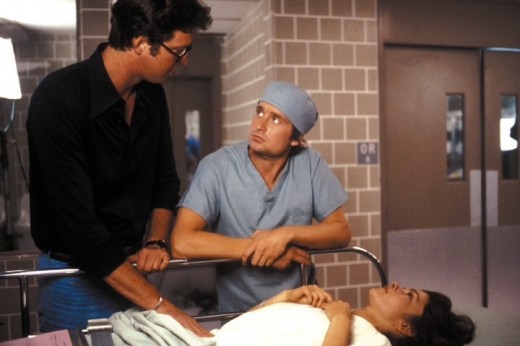 The effects of the drug mimic the symptoms of appendicitis and Harris calls for an emergency operation in . . . OR 8.
The effects of the drug mimic the symptoms of appendicitis and Harris calls for an emergency operation in . . . OR 8.
Mark is there before Susan enters, but now, when Dr. Harris is told OR 8 is unavailable and he hotly insists on OR 8, NOW, after all of her suspicions, he becomes suspicious. Remembering what she told him about the carbon monoxide line, and while the operation proceeds, he retraces her steps and disconnects the line, interrupting the lethal flow before it can do its damage.
Without what was a healthy appendix, she awakens from the operation to Dr. Harris’ great surprise. Outside the OR, two uniform policemen await. (But what of Dr. George and that assassin? A little open-ended. It can only be assumed justice was done.)
Coma is but another film, albeit part horror, that plays upon perhaps the nearly universal fear of hospitals. Apart from those films which mix murder with comedy, such as The Hospital (1971), the more serious ones are often ineffective. In the somewhat unremarkable British-made Intent to Kill (1958), a South American president, incognito for brain surgery, is threatened by killers.
Homicide and drug smuggling share equal plot elements in The Sleeping City (1950), death experiences are explored in Flatliners (1990) and in Extreme Measures (1996) a man dies mysteriously, then his body vanishes.
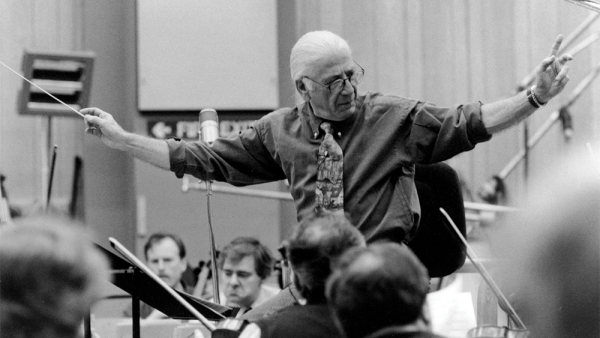 Happily, the best of the murder-in-the-hospital movies, another British effort, is Green for Danger (1946), set during the blitz of World War II. An astute Scotland Yard inspector (Alastair Sim) discovers that an OR patient has been killed by carbon monoxide—also from a green tank—predating by some thirty-two years the method used in Coma.
Happily, the best of the murder-in-the-hospital movies, another British effort, is Green for Danger (1946), set during the blitz of World War II. An astute Scotland Yard inspector (Alastair Sim) discovers that an OR patient has been killed by carbon monoxide—also from a green tank—predating by some thirty-two years the method used in Coma.
Coma is one of Jerry Goldsmith’s best scores of 1978. That year he scored six films, including The Boys from Brazil and Damien—Omen II, a follow-up to the original Omen (1976), but a film whose strongest point easily resides in the music.
The Coma score reflects the composer’s usual eclectic choice of instrumental timbre, chosen to fit a given film’s emotional temper. From the array of instruments available, here it’s strings, timpani and not one but four pianos. To help convey the nervous tension, particularly when Bujold is in harm’s way or searching the hospital, the piano strings are often plucked or rapped in the style of Charles Ives or John Cage in his “prepared piano” style.
Exceptionally, music isn’t heard until well into the film, the moment Susan’s car won’t start and she senses she’s being followed. During the opening main title credits, the audience is dropped immediately into an operating room procedure, sans music.
Echo effects—most famously Goldsmithian in Patton (1970)—add to the crescendo of fear and horror as Susan’s own awareness of things rises from casual concern to suspicion to confirmation to personal danger.
[embedyt] https://www.youtube.com/watch?v=pqUxB2l6N_Q [/embedyt]
